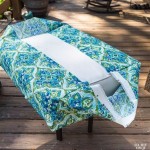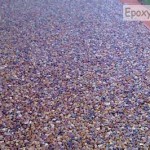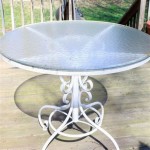How To Dye A Patio Umbrella
Patio umbrellas are a valuable addition to outdoor spaces, providing shade and protection from the elements. However, over time, the fabric can fade due to sun exposure, weather conditions, and general wear and tear. Instead of replacing the entire umbrella, dyeing the fabric offers a cost-effective and environmentally conscious solution to restore its original vibrancy or completely transform its appearance. This article provides a comprehensive guide on how to dye a patio umbrella, ensuring a successful and long-lasting result.
Assessing the Fabric and Dye Compatibility
Before embarking on the dyeing process, a thorough assessment of the umbrella's fabric composition is critical. The type of fabric will significantly influence the dye selection and the overall success of the dyeing process. Most patio umbrellas are made from materials like polyester, acrylic, cotton, or a blend of these fibers. Identifying the fabric type is essential for selecting the appropriate dye.
Polyester and acrylic fabrics are synthetic fibers that require specialized dyes designed for synthetic materials. These dyes, often referred to as disperse dyes, are engineered to penetrate and bond effectively with synthetic fibers. Natural fibers like cotton respond well to fiber-reactive dyes, which create a permanent bond with the fabric at a molecular level. Many umbrellas are made of a material that is water resistant, typically using a coating during manufacturing. It is crucial to remove this coating, as it can inhibit dye absorption. This may require a stripping agent or thorough washing prior to beginning the dyeing process.
To determine the umbrella's fabric composition, check the manufacturer's label. If the label is missing or illegible, perform a burn test on a small, inconspicuous area of the fabric. The way the fabric burns, the smell it emits, and the residue it leaves behind can provide clues about its composition. Synthetic fabrics tend to melt and produce a chemical odor, while natural fibers burn more readily and smell like burning paper. If the fabric is a blend of different fibers, it may require using a dye that is compatible with all the fibers present, or accepting that dye uptake may be uneven.
Once the fabric type is identified, research and select a dye specifically formulated for that material. Reputable dye manufacturers offer detailed product information, including fabric compatibility, color options, and application instructions. Read product reviews, test dye samples, and consult with dyeing experts to confirm that the selected dye is suitable for the specific umbrella fabric.
Preparing the Umbrella for Dyeing
Proper preparation is paramount to achieving even color distribution and optimal dye penetration. This involves cleaning the umbrella thoroughly, disassembling it as much as possible, and protecting the surrounding work area. Failure to properly prepare the umbrella can lead to uneven color, dye splotches, and unsatisfactory results.
Begin by removing any loose dirt, debris, or stains from the umbrella fabric. Use a soft brush or vacuum to remove surface dirt, and spot-clean any stains with a mild detergent and water. For stubborn stains, consider using a specialized stain remover designed for the specific type of fabric.
If the umbrella cover is removable from the frame, detach it carefully, taking photos as you go to aid in reassembly. If the cover is not removable, protect the frame and any hardware with plastic sheeting and painter’s tape. This will prevent unwanted staining of the frame and ensure a clean, professional finish. Lay down drop cloths to protect your workspace and wear gloves and eye protection to safeguard your skin and eyes from dye exposure.
Before dyeing, pre-wash the fabric to remove any remaining dirt, oil, or sizing. Use a gentle detergent and lukewarm water, and avoid using fabric softeners, as they can interfere with dye absorption. Rinse the fabric thoroughly to remove all traces of detergent, and allow it to air dry partially. The fabric should be damp but not dripping wet when you begin the dyeing process. If you believe there is still a water repellent coating on the umbrella it is recommended to use a dye-prep product such as Dharma Dye Pre-Treat. Follow the manufacturer's instructions carefully to strip the coating allowing the fabric to absorb the dye effectively.
The Dyeing Process: Immersion Dyeing
Immersion dyeing is the most common and effective method for dyeing large fabric items like patio umbrellas. This technique involves submerging the fabric in a dye bath, allowing the dye to penetrate the fibers evenly. While immersion dyeing requires a larger volume of dye and water, it ensures consistent color saturation and a uniform finish. Careful adherence to safety guidelines, precise measurement of dye and water, and consistent agitation are essential for a successful immersion dyeing process.
Choose a large, non-reactive container, such as a stainless-steel pot or a plastic tub, that is large enough to accommodate the umbrella fabric comfortably. Fill the container with hot water, following the dye manufacturer's instructions regarding water temperature and volume. The water temperature is critical for proper dye activation and penetration, so use a thermometer to ensure accuracy.
Wearing gloves and a respirator, carefully measure and mix the dye powder or liquid concentrate with a small amount of hot water to create a smooth, lump-free paste. Gradually add the dye mixture to the dye bath, stirring constantly to ensure even distribution. Add any necessary additives, such as salt or soda ash, according to the dye manufacturer's instructions. These additives help to improve dye uptake and colorfastness.
Submerge the damp umbrella fabric into the dye bath, ensuring that it is completely covered with the dye solution. Use a stirring stick or a gloved hand to agitate the fabric gently, ensuring that the dye penetrates all areas evenly. Continue stirring the fabric every few minutes for the duration of the dyeing process, which can range from 30 minutes to several hours, depending on the type of dye and the desired color intensity. The longer the fabric remains in the dye bath, the darker and more saturated the color will become.
Once the dyeing process is complete, carefully remove the fabric from the dye bath, wearing gloves to protect your hands. Rinse the fabric thoroughly under cold running water until the water runs clear. This step is crucial for removing excess dye and preventing the color from bleeding or fading. Wash the fabric separately in cold water with a mild detergent to remove any remaining dye residue. Tumble dry on low heat or hang to air dry, avoiding direct sunlight, which can cause the color to fade.
Alternative Dyeing Process: Spray Dyeing
While immersion dyeing is usually more effective, spray dyeing can be a useful alternative if you can't remove the umbrella cover, or if you are simply trying to touch up the umbrella.
As with immersion dyeing, thorough preparation is key to a successful outcome. Lay down drop cloths to protect your workspace and wear gloves and a respirator to safeguard your skin and eyes from dye exposure. Clean the umbrella thoroughly with a soft brush to remove surface dirt. Next, mix the appropriate dye with water per the manufacturer's instructions. Pour into a spray bottle.
Begin spraying with a light coat, working from top to bottom and left to right. It is best to apply multiple light coats rather than one heavy coat, which could lead to drips and uneven color distribution. After the first coat, allow the umbrella to dry and check for any areas that need to be touched up.
Continue spraying additional coats until you achieve the desired color. Once the final coat has been applied, allow the umbrella to dry completely before using. This process provides a great way to bring life back to your patio umbrella with the least amount of fuss.
Post-Dyeing Treatment and Maintenance
After the dyeing process, proper post-dyeing treatment and ongoing maintenance are essential for preserving the color and extending the lifespan of the dyed patio umbrella. These steps involve applying a color fixative, waterproofing the fabric, and following proper cleaning and storage guidelines.
A color fixative helps to lock in the dye molecules and prevent them from bleeding or fading over time. Apply a commercially available color fixative according to the manufacturer's instructions, typically by soaking the fabric in a fixative solution for a specified period. This step is particularly important for fabrics dyed with fiber-reactive dyes, as it ensures a permanent bond between the dye and the fabric.
To restore the fabric's water resistance, apply a fabric waterproofing spray after the dyeing process. Choose a waterproofing spray that is specifically designed for the type of fabric used in the umbrella. Follow the manufacturer's instructions carefully, applying the spray evenly and allowing it to dry completely before using the umbrella.
To prolong the life of the dyed patio umbrella, clean it regularly with a mild detergent and water. Avoid using harsh chemicals or abrasive cleaners, as they can damage the fabric and cause the color to fade. When not in use, store the umbrella in a dry, sheltered location to protect it from the elements. Consider using a protective umbrella cover to shield it from dust, sunlight, and moisture.
By following these detailed instructions, individuals can successfully dye their patio umbrellas and restore their beauty, extending their lifespan, and enhancing their outdoor living spaces. Proper preparation, careful dye selection, and diligent post-dyeing treatment will ensure a vibrant, long-lasting result.

How To Use Simply Spray Outdoor Fabric Paint On A Patio Umbrella

Diy Updating A Faded Patio Umbrella

How To Paint Outdoor Fabric Makeover An Old Umbrella

How To Paint A Sun Faded Old Outdoor Patio Umbrella Or Furniture With Spray Diy

How To Paint Outdoor Fabric Makeover An Old Umbrella

How To Paint A Patio Umbrella With Diy Pete

Umbrella Painting Renew Your Outdoor The Heathered Nest

Let S Spray Paint The Deck Umbrella Fabric My Perpetual Project

Let S Spray Paint The Deck Umbrella Fabric My Perpetual Project

How To Paint A Faded Outdoor Umbrella Updates On It Lasted An Oregon Cottage








